Rama Shanker
Department of Statistics, Eritrea Institute of Technology, Asmara, Eritrea
Correspondence to: Rama Shanker, Department of Statistics, Eritrea Institute of Technology, Asmara, Eritrea.
| Email: |  |
Copyright © 2016 Scientific & Academic Publishing. All Rights Reserved.
This work is licensed under the Creative Commons Attribution International License (CC BY).
http://creativecommons.org/licenses/by/4.0/

Abstract
In this paper a quasi Sujatha distribution (QSD), of which Sujatha distribution of Shanker (2016 a) is a particular case, has been proposed. Its moment generating function, moments and other related properties have been studied. Important mathematical and statistical properties including hazard rate and mean residual life functions, stochastic ordering, mean deviations, Bonferroni and Lorenz curves, and stress-strength reliability have also been discussed. Method of maximum likelihood and the method of moments have been discussed for estimating its parameters. A numerical example has been presented to test its goodness of fit and the fit is compared with other lifetime distributions.
Keywords:
Sujatha distribution, Moments, Hazard rate function, Mean residual life function, Stochastic ordering, Stress-strength reliability, Estimation of parameters, Goodness of fit
Cite this paper: Rama Shanker, A Quasi Sujatha Distribution, International Journal of Probability and Statistics , Vol. 5 No. 4, 2016, pp. 89-100. doi: 10.5923/j.ijps.20160504.01.
1. Introduction
The Sujatha distribution, introduced by Shanker (2016 a), is defined by its probability density function (p.d.f.)  | (1.1) |
Shanker (2016 a) has introduced this distribution for modeling lifetime data from engineering and biomedical science and discussed its applications for several lifetime data. It has been shown that it gives better fit than exponential and Lindley (1958) distributions. This distribution can be easily expressed as a mixture of exponential  a gamma
a gamma  and a gamma
and a gamma  distributions with their mixing proportions
distributions with their mixing proportions
 and
and  respectively. The cumulative distribution function (c.d.f.) of Sujatha distribution (1.1) obtained by Shanker (2016 a) is given by
respectively. The cumulative distribution function (c.d.f.) of Sujatha distribution (1.1) obtained by Shanker (2016 a) is given by  | (1.2) |
The first four moments about origin of Sujatha distribution (1.1) are thus obtained as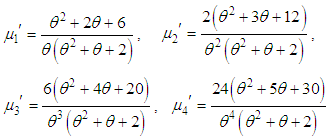 Using the relationship between moments about mean and the moments about origin, the moments about mean of the Sujatha distribution (1.1) are obtained as
Using the relationship between moments about mean and the moments about origin, the moments about mean of the Sujatha distribution (1.1) are obtained as 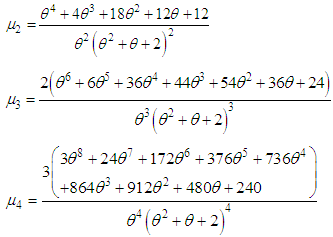 Shanker (2016 a) studied some of its important properties including skewness, kurtosis, hazard rate function, mean residual life function, stochastic ordering, mean deviations, Bonferroni and Lorenz curves, stress-strength reliability. Shanker (2016 b) has also obtained a Poisson mixture of Sujatha distribution named, “Poisson-Sujatha distribution (PSD)” and discussed its various properties, estimation of parameter and applications for counts data. Further, Shanker and Hagos (2016 a, 2015) have obtained the size-biased and zero-truncated version of PSD, discussed their statistical properties, estimation of their parameter, and applications for modeling data which structurally excludes zero-counts. Shanker and Hagos (2016 b) have detailed study about applications of PSD for modeling count data. Shanker and Hagos (2016 c) have detailed and critical study on applications of zero-truncated Poisson, Poisson-Lindley and Poisson-Sujatha distributions.In this paper, a two - parameter quasi Sujatha distribution, of which one parameter Sujatha distribution introduced by Shanker (2016 a) is a particular case, has been proposed. Its raw moments and central moments have been obtained and coefficients of variation, skewness, kurtosis and index of dispersion have been discussed. Some of its important mathematical and statistical properties including hazard rate function, mean residual life function, stochastic ordering, mean deviations, Bonferroni and Lorenz curves, stress-strength reliability have also been discussed. The estimation of the parameters has been discussed using both the maximum likelihood estimation and the method of moments. A numerical example has been given to test the goodness of fit of the distribution and the fit has been compared with other well known distributions.
Shanker (2016 a) studied some of its important properties including skewness, kurtosis, hazard rate function, mean residual life function, stochastic ordering, mean deviations, Bonferroni and Lorenz curves, stress-strength reliability. Shanker (2016 b) has also obtained a Poisson mixture of Sujatha distribution named, “Poisson-Sujatha distribution (PSD)” and discussed its various properties, estimation of parameter and applications for counts data. Further, Shanker and Hagos (2016 a, 2015) have obtained the size-biased and zero-truncated version of PSD, discussed their statistical properties, estimation of their parameter, and applications for modeling data which structurally excludes zero-counts. Shanker and Hagos (2016 b) have detailed study about applications of PSD for modeling count data. Shanker and Hagos (2016 c) have detailed and critical study on applications of zero-truncated Poisson, Poisson-Lindley and Poisson-Sujatha distributions.In this paper, a two - parameter quasi Sujatha distribution, of which one parameter Sujatha distribution introduced by Shanker (2016 a) is a particular case, has been proposed. Its raw moments and central moments have been obtained and coefficients of variation, skewness, kurtosis and index of dispersion have been discussed. Some of its important mathematical and statistical properties including hazard rate function, mean residual life function, stochastic ordering, mean deviations, Bonferroni and Lorenz curves, stress-strength reliability have also been discussed. The estimation of the parameters has been discussed using both the maximum likelihood estimation and the method of moments. A numerical example has been given to test the goodness of fit of the distribution and the fit has been compared with other well known distributions.
2. A Quasi Sujatha Distribution
A two - parameter quasi Sujatha distribution (QSD) having parameters  and
and  is defined by its probability density function (p.d.f.)
is defined by its probability density function (p.d.f.) | (2.1) |
It can be easily verified that at  , (2.1) reduces to the Sujatha distribution (1.1) and at
, (2.1) reduces to the Sujatha distribution (1.1) and at  it reduces to the size-biased Lindley distribution (SBLD) given by its p.d.f.
it reduces to the size-biased Lindley distribution (SBLD) given by its p.d.f. | (2.2) |
It can be easily verified that QSD (2.1) is a three-component mixture of exponential  gamma
gamma  and gamma distributions. We have
and gamma distributions. We have | (2.3) |
where  The corresponding cumulative distribution function of QSD (2.1) can be obtained as
The corresponding cumulative distribution function of QSD (2.1) can be obtained as | (2.4) |
3. Moments and Related Measures
The moment generating function of QSD (2.1) are obtained as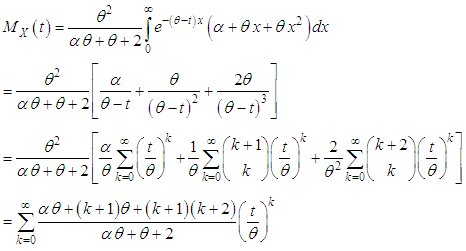 Thus, the
Thus, the  moment about origin of QSD obtained as the coefficient of
moment about origin of QSD obtained as the coefficient of  is given by
is given by | (3.1) |
The first four moments about origin of QSD are given by , The moments about mean of QSD are thus obtained as
, The moments about mean of QSD are thus obtained as  The coefficient of variation
The coefficient of variation coefficient of skewness
coefficient of skewness coefficient of kurtosis
coefficient of kurtosis  and index of dispersion
and index of dispersion  of QSD are given by
of QSD are given by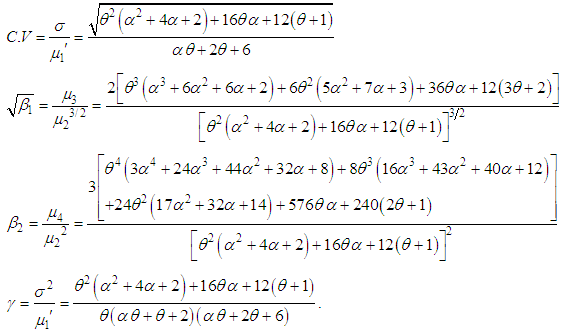 To study the nature of C.V,
To study the nature of C.V,  of QSD, the numerical values of these constants have been computed for varing values of the parameters and presented in tables 3.1, 3.2, 3.3, and 3.4
of QSD, the numerical values of these constants have been computed for varing values of the parameters and presented in tables 3.1, 3.2, 3.3, and 3.4Table 3.1. CV of QSD for varying values of θ and α
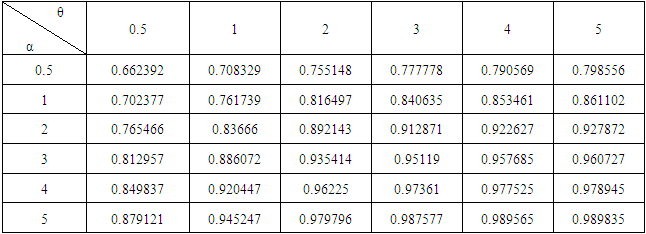 |
| |
|
It is clear from table 3.1 that for a given value of  C.V increases as the value of
C.V increases as the value of  increases.
increases.Table 3.2.
 of QSD for varying values of θ and α of QSD for varying values of θ and α
 |
| |
|
It is obvious from the table 3.2 that for a given value of  increases as the value of
increases as the value of  increases.
increases.Table 3.3.
 of QSD for varying values of θ and α of QSD for varying values of θ and α
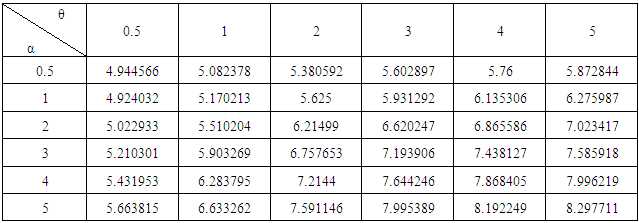 |
| |
|
Table 3.3 reveals that for a given value of  increases as the value of
increases as the value of  increases. For
increases. For  and
and  decreases. Again for a given value of
decreases. Again for a given value of  increases as the value of
increases as the value of  increases.
increases.Table 3.4.
 of QSD for varying values of θ and α of QSD for varying values of θ and α
 |
| |
|
It is obvious from table 3.4 that for a given value of  decreases (increases) as the value of
decreases (increases) as the value of  increases.
increases.
4. Hazard Rate Function and Mean Residual Life Function
Let  be a continuous random variable with p.d.f.
be a continuous random variable with p.d.f.  and c.d.f.
and c.d.f.  The hazard rate function (also known as the failure rate function) and the mean residual life function of
The hazard rate function (also known as the failure rate function) and the mean residual life function of  are respectively defined as
are respectively defined as  | (4.1) |
and | (4.2) |
The corresponding hazard rate function,  and the mean residual life function,
and the mean residual life function,  of QSD (2.1) are obtained as
of QSD (2.1) are obtained as  | (4.3) |
and  | (4.4) |
It can be easily verified that  and
and 
5. Stochastic Orderings
Stochastic ordering of positive continuous random variables is an important tool for judging their comparative behavior. A random variable  is said to be smaller than a random variable
is said to be smaller than a random variable  in the (i) stochastic order
in the (i) stochastic order  for all
for all  (ii) hazard rate order
(ii) hazard rate order  for all
for all  (iii) mean residual life order
(iii) mean residual life order  for all
for all  (iv) likelihood ratio order
(iv) likelihood ratio order  decreases in
decreases in  The following results due to Shaked and Shanthikumar (1994) are well known for establishing stochastic ordering of distributions
The following results due to Shaked and Shanthikumar (1994) are well known for establishing stochastic ordering of distributions | (5.1) |
The QSD is ordered with respect to the strongest ‘likelihood ratio ordering’ as shown in the following theorem:Theorem: Let  and
and  If
If or
or  then
then  and hence
and hence  and
and  Proof: We have
Proof: We have  Now
Now  This gives
This gives  Thus if
Thus if or
or  This means that
This means that  and hence
and hence  and
and  This shows flexibility over Sujatha distribution introduced by Shanker (2016 a).
This shows flexibility over Sujatha distribution introduced by Shanker (2016 a).
6. Mean Deviations
The amount of scatter in a population is measured to some extent by the totality of deviations usually from mean and median. These are known as the mean deviation about the mean and the mean deviation about the median defined by and
and  , respectively, where
, respectively, where  and
and  The measures
The measures  and
and  can be calculated using the following simplified relationships
can be calculated using the following simplified relationships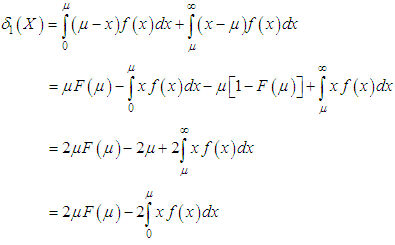 | (6.1) |
and 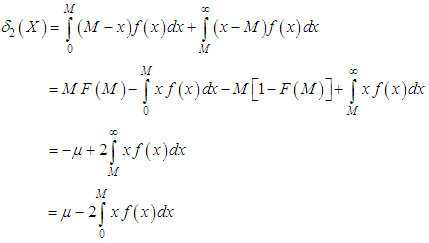 | (6.2) |
Using p.d.f. (2.1) and expression for the mean of QSD, we get  | (6.3) |
 | (6.4) |
Using expressions from (6.1), (6.2), (6.3), and (6.4), the mean deviation about mean,  and the mean deviation about median,
and the mean deviation about median,  of QSD are obtained as
of QSD are obtained as | (6.5) |
 | (6.6) |
7. Bonferroni and Lorenz Curves
The Bonferroni and Lorenz curves (Bonferroni, 1930) and Bonferroni and Gini indices have applications not only in economics to study income and poverty, but also in other fields like reliability, demography, insurance and medicine. The Bonferroni and Lorenz curves are defined as | (7.1) |
and  | (7.2) |
respectively or equivalently  | (7.3) |
and | (7.4) |
respectively, where  and
and  The Bonferroni and Gini indices are thus defined as
The Bonferroni and Gini indices are thus defined as | (7.5) |
and | (7.6) |
respectively.Using p.d.f. of QSD (2.1), we get  | (7.7) |
Now using equation (7.7) in (7.1) and (7.2), we get  | (7.8) |
and | (7.9) |
Now using equations (7.8) and (7.9) in (7.5) and (7.6), the Bonferroni and Gini indices of QSD are thus obtained as | (7.10) |
 | (7.11) |
8. Estimation of Parameters
8.1. Maximum Likelihood Estimates (MLE)
Let  be a random sample from QSD (2.1)). The likelihood function,
be a random sample from QSD (2.1)). The likelihood function,  of (2.1) is given by
of (2.1) is given by and so its natural log likelihood function is thus obtained as
and so its natural log likelihood function is thus obtained as | (8.1.1) |
The maximum likelihood estimates (MLEs)  are then the solutions of the following non-linear equations
are then the solutions of the following non-linear equations where
where  is the sample mean.These two natural log likelihood equations do not seem to be solved directly. However, the Fisher’s scoring method can be applied to solve these equations. We have
is the sample mean.These two natural log likelihood equations do not seem to be solved directly. However, the Fisher’s scoring method can be applied to solve these equations. We have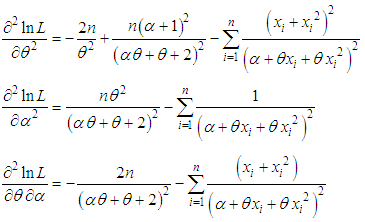 The following equations can be solved for MLEs
The following equations can be solved for MLEs  of QSD
of QSD where
where  are the initial values of
are the initial values of  respectively. These equations are solved iteratively till sufficiently close values of
respectively. These equations are solved iteratively till sufficiently close values of  are obtained.
are obtained.
8.2. Method of Moments Estimates (MOME)
Since the QSD (2.1) has two parameters to be estimated, the first two moments about origin are required to estimate its parameters. Equating the population mean to the sample mean, we have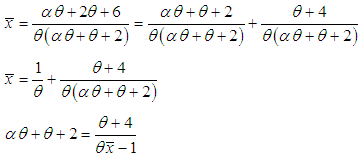 | (8.2.1) |
Again replacing the second population moment with the corresponding sample moment, we have | (8.2.2) |
Equations (8.2.1) and (8.2.2) gives the following cubic equation in 
 | (8.2.3) |
Solving equation (8.2.3) using any iterative methods such as Newton-Raphson method, Regula -Falsi method or Bisection method, method of moment estimate (MOME)  can be obtained and substituting the value of
can be obtained and substituting the value of  in equation (8.2.1), MOME
in equation (8.2.1), MOME  can be obtained as
can be obtained as | (8.2.4) |
9. Stress-Strength Reliability
The stress- strength reliability describes the life of a component which has random strength  that is subjected to a random stress
that is subjected to a random stress  When the stress applied to it exceeds the strength, the component fails instantly and the component will function satisfactorily till
When the stress applied to it exceeds the strength, the component fails instantly and the component will function satisfactorily till  . Therefore,
. Therefore,  is a measure of component reliability and in statistical literature it is known as stress-strength parameter. It has wide applications in almost all areas of knowledge especially in engineering such as structures, deterioration of rocket motors, static fatigue of ceramic components, aging of concrete pressure vessels etc.Let
is a measure of component reliability and in statistical literature it is known as stress-strength parameter. It has wide applications in almost all areas of knowledge especially in engineering such as structures, deterioration of rocket motors, static fatigue of ceramic components, aging of concrete pressure vessels etc.Let  and
and  be independent strength and stress random variables having QSD (2.1) with parameter
be independent strength and stress random variables having QSD (2.1) with parameter  and
and  respectively. Then the stress-strength reliability
respectively. Then the stress-strength reliability  can be obtained as
can be obtained as It can be easily verified that above expression reduces to the corresponding expression for Sujatha distribution (1.1) at
It can be easily verified that above expression reduces to the corresponding expression for Sujatha distribution (1.1) at  and
and 
10. Illustrative Example
The following data set represents the failure times (in minutes) for a sample of 15 electronic components in an accelerated life test, Lawless (2003, pp.204) For this data set, QSD has been fitted along with one parameter exponential, Lindley and Akash distributions and two - parameter weighted Lindley (WLD), Weibull, Gamma and Lognormal distributions. The probability density function (p.d.f.), and the cumulative distribution function (c.d.f.) of weighted Lindley, Weibull, Gamma, Lognormal, Lindley and exponential distributions are presented in table 10.5. The ML estimates, values of
For this data set, QSD has been fitted along with one parameter exponential, Lindley and Akash distributions and two - parameter weighted Lindley (WLD), Weibull, Gamma and Lognormal distributions. The probability density function (p.d.f.), and the cumulative distribution function (c.d.f.) of weighted Lindley, Weibull, Gamma, Lognormal, Lindley and exponential distributions are presented in table 10.5. The ML estimates, values of  and K-S statistics of the fitted distributions are presented in table 10.6. Recall that the best distribution corresponds to the lower values of
and K-S statistics of the fitted distributions are presented in table 10.6. Recall that the best distribution corresponds to the lower values of  and K-S.
and K-S. Table 10.5. The p.d.f. and the c.d.f. of fitted distributions
 |
| |
|
Table 10.6. MLE’s, - 2ln Land K-S Statistics of the fitted distributions
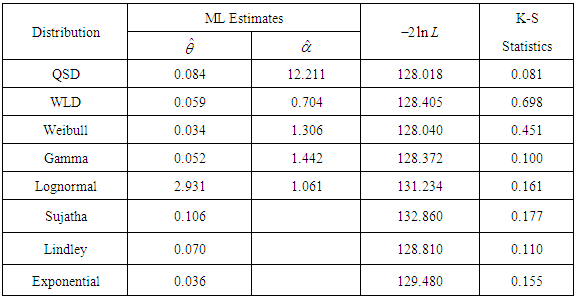 |
| |
|
11. Concluding Remarks
A two - parameter quasi Sujatha distribution (QSD) which includes one parameter Sujatha distribution as a particular case has been proposed and studied. Its mathematical properties including moments, coefficient of variation, skewness, kurtosis, index of dispersion, hazard rate function, mean residual life function, stochastic ordering, mean deviations, Bonferroni and Lorenz curves, and stress-strength reliability have been discussed. The method of moments and the method of maximum likelihood estimation have also been discussed for estimating its parameters. Finally, a numerical example of real lifetime data set has been presented to test the goodness of fit of the QSD over exponential, Lindley, Sujatha, Lognormal, Gamma, Weibull and WLD.
ACKNOWLEDGEMENTS
The author express his gratitude to the editor in-chief and the anonymous reviewer for constructive comments.
References
| [1] | Bonferroni, C.E. (1930): Elementi di Statistca generale, Seeber, Firenze. |
| [2] | Lawless, J.F. (2003): Statistical Models and Methods for Lifetime data, John Wiley and Sons, New York. |
| [3] | Lindley, D.V. (1958): Fiducial distributions and Bayes’ theorem, Journal of the Royal Statistical Society, Series B, 20, 102- 107. |
| [4] | Shaked, M. and Shanthikumar, J.G. (1994): Stochastic Orders and Their Applications, Academic Press, New York. |
| [5] | Shanker, R. (2016a): Sujatha distribution and Its Applications, Statistics in Transition new series, 17 (3). |
| [6] | Shanker, R. (2016b): The discrete Poisson-Sujatha distribution, International Journal of Probability and Statistics, 5(1), 1 – 9. |
| [7] | Shanker, R. and Hagos, F. (2015): Zero-truncated Poisson-Sujatha distribution with Applications, Journal of Ethiopian Statistical Association, 24, 55 – 63. |
| [8] | Shanker, R. and Hagos, F. (2016a): Size-biased Poisson-Sujatha distribution with Applications, American Journal of Mathematics and Statistics, 6(4), 145 – 154. |
| [9] | Shanker, R. and Hagos, F. (2016b): On Poisson-Sujatha Distribution and Its Applications to Model count data from Biological Sciences, Biometrics and Biostatistics International Journal, 3(4), 1 – 7. |
| [10] | Shanker, R. and Hagos, F. (2016c): On Zero-truncation of Poisson, Poisson-Lindley and Poisson-Sujatha distributions and their Applications, Biometrics and Biostatistics International Journal, 3(5), 1 – 13. |




 a gamma
a gamma  and a gamma
and a gamma  distributions with their mixing proportions
distributions with their mixing proportions
 and
and  respectively. The cumulative distribution function (c.d.f.) of Sujatha distribution (1.1) obtained by Shanker (2016 a) is given by
respectively. The cumulative distribution function (c.d.f.) of Sujatha distribution (1.1) obtained by Shanker (2016 a) is given by 
 Using the relationship between moments about mean and the moments about origin, the moments about mean of the Sujatha distribution (1.1) are obtained as
Using the relationship between moments about mean and the moments about origin, the moments about mean of the Sujatha distribution (1.1) are obtained as  Shanker (2016 a) studied some of its important properties including skewness, kurtosis, hazard rate function, mean residual life function, stochastic ordering, mean deviations, Bonferroni and Lorenz curves, stress-strength reliability. Shanker (2016 b) has also obtained a Poisson mixture of Sujatha distribution named, “Poisson-Sujatha distribution (PSD)” and discussed its various properties, estimation of parameter and applications for counts data. Further, Shanker and Hagos (2016 a, 2015) have obtained the size-biased and zero-truncated version of PSD, discussed their statistical properties, estimation of their parameter, and applications for modeling data which structurally excludes zero-counts. Shanker and Hagos (2016 b) have detailed study about applications of PSD for modeling count data. Shanker and Hagos (2016 c) have detailed and critical study on applications of zero-truncated Poisson, Poisson-Lindley and Poisson-Sujatha distributions.In this paper, a two - parameter quasi Sujatha distribution, of which one parameter Sujatha distribution introduced by Shanker (2016 a) is a particular case, has been proposed. Its raw moments and central moments have been obtained and coefficients of variation, skewness, kurtosis and index of dispersion have been discussed. Some of its important mathematical and statistical properties including hazard rate function, mean residual life function, stochastic ordering, mean deviations, Bonferroni and Lorenz curves, stress-strength reliability have also been discussed. The estimation of the parameters has been discussed using both the maximum likelihood estimation and the method of moments. A numerical example has been given to test the goodness of fit of the distribution and the fit has been compared with other well known distributions.
Shanker (2016 a) studied some of its important properties including skewness, kurtosis, hazard rate function, mean residual life function, stochastic ordering, mean deviations, Bonferroni and Lorenz curves, stress-strength reliability. Shanker (2016 b) has also obtained a Poisson mixture of Sujatha distribution named, “Poisson-Sujatha distribution (PSD)” and discussed its various properties, estimation of parameter and applications for counts data. Further, Shanker and Hagos (2016 a, 2015) have obtained the size-biased and zero-truncated version of PSD, discussed their statistical properties, estimation of their parameter, and applications for modeling data which structurally excludes zero-counts. Shanker and Hagos (2016 b) have detailed study about applications of PSD for modeling count data. Shanker and Hagos (2016 c) have detailed and critical study on applications of zero-truncated Poisson, Poisson-Lindley and Poisson-Sujatha distributions.In this paper, a two - parameter quasi Sujatha distribution, of which one parameter Sujatha distribution introduced by Shanker (2016 a) is a particular case, has been proposed. Its raw moments and central moments have been obtained and coefficients of variation, skewness, kurtosis and index of dispersion have been discussed. Some of its important mathematical and statistical properties including hazard rate function, mean residual life function, stochastic ordering, mean deviations, Bonferroni and Lorenz curves, stress-strength reliability have also been discussed. The estimation of the parameters has been discussed using both the maximum likelihood estimation and the method of moments. A numerical example has been given to test the goodness of fit of the distribution and the fit has been compared with other well known distributions. and
and  is defined by its probability density function (p.d.f.)
is defined by its probability density function (p.d.f.)
 , (2.1) reduces to the Sujatha distribution (1.1) and at
, (2.1) reduces to the Sujatha distribution (1.1) and at  it reduces to the size-biased Lindley distribution (SBLD) given by its p.d.f.
it reduces to the size-biased Lindley distribution (SBLD) given by its p.d.f.
 gamma
gamma  and gamma distributions. We have
and gamma distributions. We have
 The corresponding cumulative distribution function of QSD (2.1) can be obtained as
The corresponding cumulative distribution function of QSD (2.1) can be obtained as
 Thus, the
Thus, the  moment about origin of QSD obtained as the coefficient of
moment about origin of QSD obtained as the coefficient of  is given by
is given by
 , The moments about mean of QSD are thus obtained as
, The moments about mean of QSD are thus obtained as  The coefficient of variation
The coefficient of variation coefficient of skewness
coefficient of skewness coefficient of kurtosis
coefficient of kurtosis  and index of dispersion
and index of dispersion  of QSD are given by
of QSD are given by To study the nature of C.V,
To study the nature of C.V,  of QSD, the numerical values of these constants have been computed for varing values of the parameters and presented in tables 3.1, 3.2, 3.3, and 3.4
of QSD, the numerical values of these constants have been computed for varing values of the parameters and presented in tables 3.1, 3.2, 3.3, and 3.4 C.V increases as the value of
C.V increases as the value of  increases.
increases. increases as the value of
increases as the value of  increases.
increases. increases as the value of
increases as the value of  increases. For
increases. For  and
and  decreases. Again for a given value of
decreases. Again for a given value of  increases as the value of
increases as the value of  increases.
increases. decreases (increases) as the value of
decreases (increases) as the value of  increases.
increases. be a continuous random variable with p.d.f.
be a continuous random variable with p.d.f.  and c.d.f.
and c.d.f.  The hazard rate function (also known as the failure rate function) and the mean residual life function of
The hazard rate function (also known as the failure rate function) and the mean residual life function of  are respectively defined as
are respectively defined as 

 and the mean residual life function,
and the mean residual life function,  of QSD (2.1) are obtained as
of QSD (2.1) are obtained as 

 and
and 
 is said to be smaller than a random variable
is said to be smaller than a random variable  in the (i) stochastic order
in the (i) stochastic order  for all
for all  (ii) hazard rate order
(ii) hazard rate order  for all
for all  (iii) mean residual life order
(iii) mean residual life order  for all
for all  (iv) likelihood ratio order
(iv) likelihood ratio order  decreases in
decreases in  The following results due to Shaked and Shanthikumar (1994) are well known for establishing stochastic ordering of distributions
The following results due to Shaked and Shanthikumar (1994) are well known for establishing stochastic ordering of distributions
 and
and  If
If or
or  then
then  and hence
and hence  and
and  Proof: We have
Proof: We have  Now
Now  This gives
This gives  Thus if
Thus if or
or  This means that
This means that  and hence
and hence  and
and  This shows flexibility over Sujatha distribution introduced by Shanker (2016 a).
This shows flexibility over Sujatha distribution introduced by Shanker (2016 a). and
and  , respectively, where
, respectively, where  and
and  The measures
The measures  and
and  can be calculated using the following simplified relationships
can be calculated using the following simplified relationships



 and the mean deviation about median,
and the mean deviation about median,  of QSD are obtained as
of QSD are obtained as





 and
and  The Bonferroni and Gini indices are thus defined as
The Bonferroni and Gini indices are thus defined as






 be a random sample from QSD (2.1)). The likelihood function,
be a random sample from QSD (2.1)). The likelihood function,  of (2.1) is given by
of (2.1) is given by and so its natural log likelihood function is thus obtained as
and so its natural log likelihood function is thus obtained as
 are then the solutions of the following non-linear equations
are then the solutions of the following non-linear equations where
where  is the sample mean.These two natural log likelihood equations do not seem to be solved directly. However, the Fisher’s scoring method can be applied to solve these equations. We have
is the sample mean.These two natural log likelihood equations do not seem to be solved directly. However, the Fisher’s scoring method can be applied to solve these equations. We have The following equations can be solved for MLEs
The following equations can be solved for MLEs  of QSD
of QSD where
where  are the initial values of
are the initial values of  respectively. These equations are solved iteratively till sufficiently close values of
respectively. These equations are solved iteratively till sufficiently close values of  are obtained.
are obtained. 



 can be obtained and substituting the value of
can be obtained and substituting the value of  in equation (8.2.1), MOME
in equation (8.2.1), MOME  can be obtained as
can be obtained as
 that is subjected to a random stress
that is subjected to a random stress  When the stress applied to it exceeds the strength, the component fails instantly and the component will function satisfactorily till
When the stress applied to it exceeds the strength, the component fails instantly and the component will function satisfactorily till  . Therefore,
. Therefore,  is a measure of component reliability and in statistical literature it is known as stress-strength parameter. It has wide applications in almost all areas of knowledge especially in engineering such as structures, deterioration of rocket motors, static fatigue of ceramic components, aging of concrete pressure vessels etc.Let
is a measure of component reliability and in statistical literature it is known as stress-strength parameter. It has wide applications in almost all areas of knowledge especially in engineering such as structures, deterioration of rocket motors, static fatigue of ceramic components, aging of concrete pressure vessels etc.Let  and
and  be independent strength and stress random variables having QSD (2.1) with parameter
be independent strength and stress random variables having QSD (2.1) with parameter  and
and  respectively. Then the stress-strength reliability
respectively. Then the stress-strength reliability  can be obtained as
can be obtained as It can be easily verified that above expression reduces to the corresponding expression for Sujatha distribution (1.1) at
It can be easily verified that above expression reduces to the corresponding expression for Sujatha distribution (1.1) at  and
and 
 For this data set, QSD has been fitted along with one parameter exponential, Lindley and Akash distributions and two - parameter weighted Lindley (WLD), Weibull, Gamma and Lognormal distributions. The probability density function (p.d.f.), and the cumulative distribution function (c.d.f.) of weighted Lindley, Weibull, Gamma, Lognormal, Lindley and exponential distributions are presented in table 10.5. The ML estimates, values of
For this data set, QSD has been fitted along with one parameter exponential, Lindley and Akash distributions and two - parameter weighted Lindley (WLD), Weibull, Gamma and Lognormal distributions. The probability density function (p.d.f.), and the cumulative distribution function (c.d.f.) of weighted Lindley, Weibull, Gamma, Lognormal, Lindley and exponential distributions are presented in table 10.5. The ML estimates, values of  and K-S statistics of the fitted distributions are presented in table 10.6. Recall that the best distribution corresponds to the lower values of
and K-S statistics of the fitted distributions are presented in table 10.6. Recall that the best distribution corresponds to the lower values of  and K-S.
and K-S.  Abstract
Abstract Reference
Reference Full-Text PDF
Full-Text PDF Full-text HTML
Full-text HTML
 of QSD for varying values of θ and α
of QSD for varying values of θ and α
 of QSD for varying values of θ and α
of QSD for varying values of θ and α
 of QSD for varying values of θ and α
of QSD for varying values of θ and α

